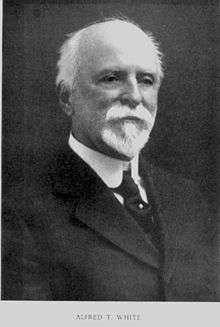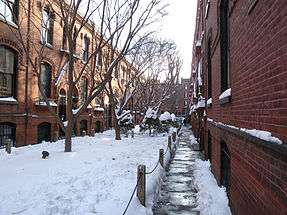Alfred Tredway White
| Alfred Tredway White | |
|---|---|
 | |
| Born |
May 28, 1846 Brooklyn, New York |
| Died |
January 29, 1921 (aged 74) Central Valley, New York, USA[1] |
| Nationality | American |
| Known for | Social reform, philanthropy |
Alfred Tredway White (May 28, 1846 – January 29, 1921) was an American housing reformer and philanthropist, and was known as "Brooklyn's first citizen."[1] He developed the Home Buildings (1877), Tower Buildings (1879, now Cobble Hill Towers)[2] and the Riverside Buildings (1890).[3] He advocated a model of "philanthropy plus five percent," accepting a limited financial return on his projects.[4]

White's buildings were extensively praised by Jacob Riis in "How The Other Half Lives" as a "beau ideal" and a "big village of contented people."[5] They covered roughly half of their lots, leaving large courtyards suitable for concerts and other recreation.[6]
He served as Commissioner of City Works for Brooklyn during the administration of Mayor Schieren.[7]
He was an early benefactor of the Brooklyn Botanic Garden, and is memorialized there by the Alfred T. White Memorial and Amphitheater.[8][9] He was also a major supporter of both the Hampton Institute and Tuskegee Institute. He was a member of the Unitarian Universalist church.[3]
References
| Wikimedia Commons has media related to Alfred Tredway White. |
- 1 2 "Alfred T. White, Brooklyn Philanthropist, Leaves $15,000,000 Estate to Daughter". The New York Times. February 20, 1921. Retrieved 18 September 2013.
[D]rowned on Jan. 29 while skating in Central Valley, N.Y.
- ↑ Gray, Christopher (October 10, 2008). "Architectural Wealth, Built for the Poor". The New York Times. Retrieved 18 September 2013.
- 1 2 Hoogenboom, Olive. "Alfred T. White". Dictionary of Unitarian & Universalist Biography. Unitarian Universalist History & Heritage Society. Archived from the original on 2012-06-21. Retrieved 18 September 2013.
- ↑ Jamieson, Wendell (January 24, 2003). "Landmark Towers, Still Loved and Lived In". The New York Times. Retrieved 18 September 2013.
- ↑ Riis, Jacob (1890). How the Other Half Lives. Macmillan. p. 264. ISBN 0312574010.
- ↑ Gray, Christopher (August 23, 1992). "The Riverside Buildings; A Model Tenement In Dickensian Style". The New York Times. Retrieved 18 September 2013.
- ↑ "WHAT ALFRED T. WHITE HAS SPENT; Mayor Schieren Learns How One Man He Appointed Has Save Brooklyn Money Without Penury". The New York Times. October 25, 1895. Retrieved 18 September 2013.
- ↑ Furman, Bob. "Heights History: Alfred T. White". Retrieved 18 September 2013.
- ↑ "Alfred T. White Amphitheater - Brooklyn Botanic Garden". Brooklyn Botanic Garden.